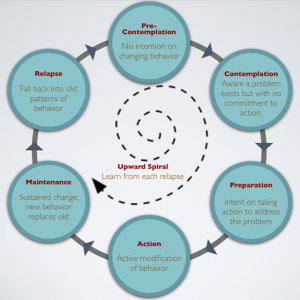Understanding Change
Part of our Real Chemistry series – connection, wellbeing and chemsex recovery.
This page introduces information about understanding & making changes, and now you have identified the harms that arose for you through your chemsex engagement, thinking about and implementing change is a positive step towards improving your wellbeing, After you have read through the information there are some exercises for you to work through, thinking about the changes you wish to make – and sustain. You may find it helpful to have a notebook to use as you work through the exercises, or you could use the function on a phone or tablet.
![]()
Change
Think and reflect on the theme of change, and consider the following questions:
What does change mean to you? What kind of changes have you made in the past, and how did you make these changes? What was the impact of these changes on your physical, and psychological well-being?
What changes have you made around your chem use? Have you managed to keep to these changes? What was difficult about making these changes? What was the positive outcome of these changes?
![]()
To Change...
…we have to learn how to be our own best buddies, and focus on our own self care rather than listening to our internal critic, who doesn’t always have our best interests at heart. We need to learn to nurture ourselves by changing the words we use to motivate ourselves.
An example of this is to say, ‘Going for a walk will benefit our wellbeing!’, rather than using terminology that is unhelpful to your wellbeing.
Feeling bullied to change (by anyone, and especially ourselves by listening to our internal critic) is a recipe for feeling unmotivated, and experiences of low mood, both of which will probably lead to feelings of failure. All in all, these feelings will not help anyone change for the better.
![]()
Is Change Necessary?
Change is essential for your growth and development, which as human beings is a very natural part of life. Without change, it’s safe to say that we just stay the way we are (even if we are desperately unhappy).
For some people, no change is a good thing; they're happy and fulfilled in their lives. But for many people, the current path they are on lacks meaning and satisfaction and they feel stuck, and even though change is desirable, it may feel impossible to figure out how to start the process of change.
![]()
Is Change Difficult?
Answer: Yes & No.
No: In simple terms, change doesn't seem like it should be difficult to implement and if there is something that you are unhappy with in your life, or you don't like something about yourself or your habits, then you can just take some simple steps to change it.
Yes: However the reality is that change may be a slow process, can feel frustrating, and sometimes even painful, and can often be the most difficult, yet rewarding thing you will ever do.
![]()
Obstacles to Change
An unfortunate part of life is that we often create obstacles or barriers that stop us from living our best life. Generally we can see these obstacles as an unconscious process, that may come from feelings of uncertainty of taking risks, and fear of the unknown.
Some obstacles to change that may resonate with you are:
The past: We bring positive ways of being into adulthood from our childhood, but we may also bring which are less positive and that sometimes act contrary to our own wellbeing and mental health, and can be deemed as unhealthy baggage
Some examples of 'the past' may include low self-esteem, the need to appear perfect, a need for control, and the more negative emotions such as fear & anger.. These experiences may cause us to think, feel, as well as behave based on who we were as young people rather than who we are as adults and can often result in sabotaging our own efforts to implement positive life change.
The challenge then is to identify what we carry from the past, as well as what small steps can be taken to change them.
Habits: When we experience thoughts, emotions, and behaviour that are driven by our past experiences, they can become habits that we turn to when reacting to what we experience in the world. These habits can then cause us to respond to life events in an unhealthy, passive or adaptive way.
The challenge then is to identify what habits you may have, as well as what small steps can be taken to change them.
Emotions: We tend to view fear, anger, sadness, frustration, and hopelessness as the more negative emotional states, and it’s probably safe to say that we have all experienced these feelings as being a huge barrier in moving towards the life that we want.
The impact of these negative emotions become huge barriers to change since they can trigger uncomfortable feelings that can make us want to retreat, and stop the process of change in its track.
The challenge then is to identify what feelings come up for you when you think about change, as well as what small steps can be taken to change them.
Environment: Unfortunately we often create an environment where our baggage, habits, and emotions are played. However this ‘safety’ of our environment is a huge obstacle to change, and sometimes it is necessary to consider stepping out of our comfort zone so that we can set the stage for change.
The challenge then is to identify how your environment stops you feeling that you need to change or that staying the same is okay, as well as what small steps can be taken to change them.
In all cases, when you allow these obstacles to control your life, they have the effect of sabotaging your efforts at changing your life in a positive way. Even worse, you may feel stuck, frustrated, and helpless to change your lot in life.
![]()
Moving Through These Obstacles
Some questions for you to reflect on, and which that may support you moving through any obstacles in your way, are:
- Do I really want to make the change I say I want to?
- What are my fears if I make this change?
- What will I lose or open myself up to?
- Do I really want to make the effort required to make this change? If so then what impact do I want this change to have?
Being honest about your capabilities and limitations will help you set goals that are reachable, and achievable.
![]()
The Cycle of Change
The Cycle of Change is a really good tool that you can use, to help you identify where you are in terms of your thinking & feeling about change, as well as where you are in terms of taking action towards implementing long lasting change. The Cycle of Change also helps us identity and understand that the process of change is actually a continually ongoing process, that involves trial & error, adaption, and as additional and further changes.

In terms of your own ideas around the change you want to make or have recently made, can you identify which stage you are currently in?
![]()
Exercises
- If I had a magic wand…
What would be the changes you would make in your life?
- Five steps to change.
Thinking of one change you would like to make, think of 5 steps you could take to achieve this.
1.
2.
3.
4.
5.





